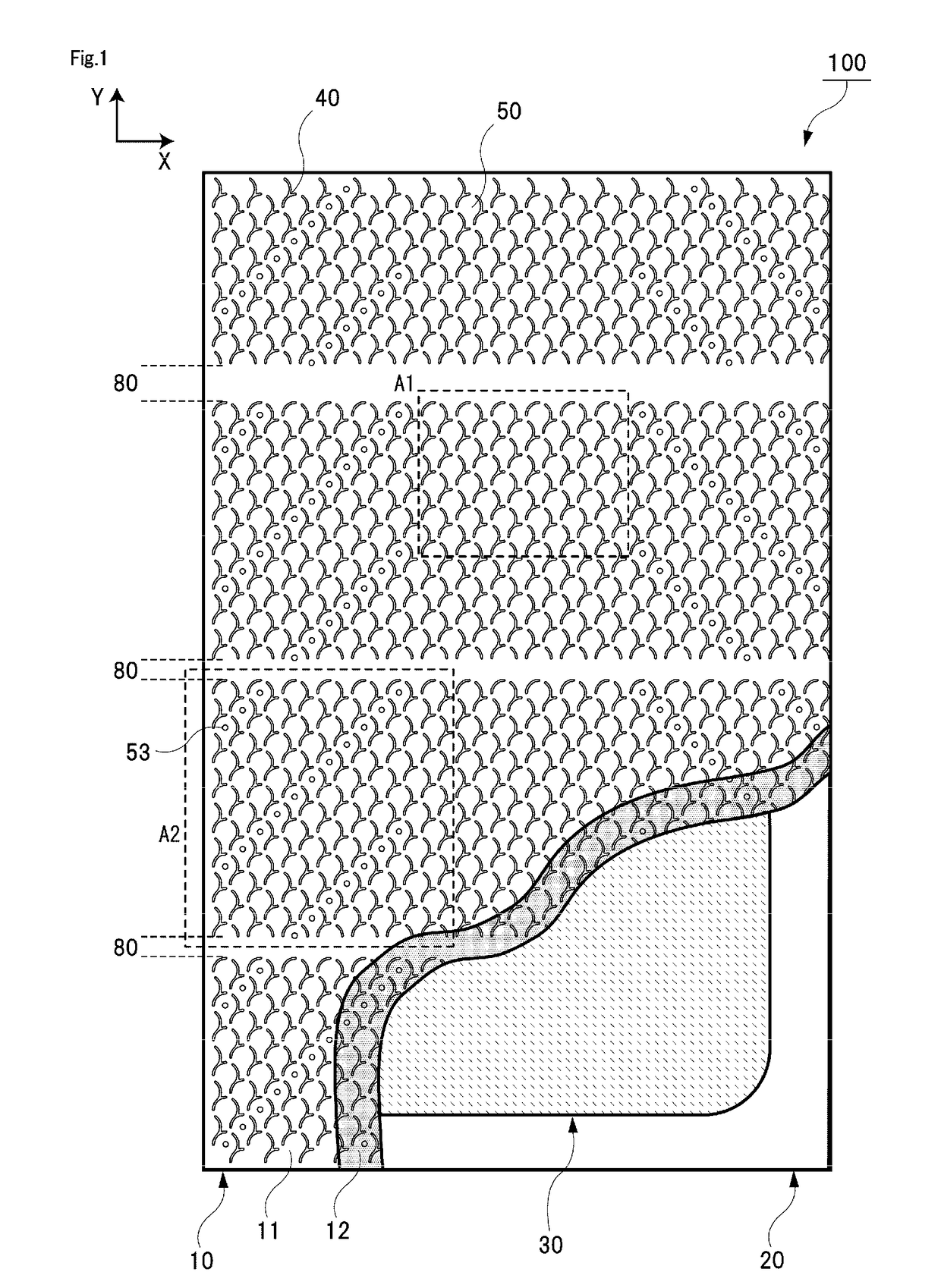Top Sheet For Absorbent Articles
- Summary
- Abstract
- Description
- Claims
- Application Information
AI Technical Summary
Benefits of technology
Problems solved by technology
Method used
Image
Examples
first embodiment
1. When Inside of Small Region is Filled with Fiber
[0069]A description will be given of a first embodiment of a disposable diaper according to the invention with reference to FIG. 1 to FIG. 7(c). The first embodiment is a mode in which an inside of a small region 52 of an upper layer sheet 11 described below is filled with fiber.
[0070]FIG. 1 is a plan view of an absorbent article 100 according to the first embodiment of the invention viewed from a skin facing surface side. For example, the absorbent article 100 according to the invention may be used for a disposable diaper, a urine pad, a panty liner, a light incontinence pad, and a sanitary napkin. FIG. 1 schematically illustrates an internal structure of the absorbent article 100. As illustrated in FIG. 1, the absorbent article 100 includes a top sheet 10, a back sheet 20, and an absorber 30. The top sheet 10 is a sheet disposed on a skin facing surface side of the absorber 30 to directly come into contact with a skin of a wearer...
second embodiment
2. When Small Region Holds Space Therein
[0114]Next, a description will be given of a second embodiment of the disposable diaper according to the invention with reference to FIG. 8(a) to FIG. 10. The second embodiment corresponds to a mode in which the small region 52 of the upper layer sheet 11 holds a space therein. In description of the second embodiment, a similar configuration to that of the above-described first embodiment will not be described, and a difference from the first embodiment will be described in detail.
[0115]FIGS. 7(a) to 7(c) illustrate cross-sectional views of a top sheet according to the second embodiment, and correspond to FIGS. 5(a) to 5(c). FIG. 7(b) is a cross-section view taken along Y-Y line illustrated in FIG. 7(a), and FIG. 7(c) is a cross-section view taken along X-X line illustrated in FIG. 7(a). As illustrated in FIGS. 7(b) and 7(c), the large region 51 and the small region 52 of the non-joining portion 50 are formed in dome shapes that hold spaces t...
first modified example
4-1. First Modified Example
[0163]FIG. 15 illustrates a first modified example of the embossing pattern formed on the top sheet. As illustrated in FIG. 15, in the first modified example, a joining portion group including a plurality of joining portions 40 that surrounds one non-joining portion 50 has an asymmetric shape similarly to the embodiment of FIG. 14. In more detail, in Modified Example 1, the joining portion group satisfies requirements below.
[0164](1) The joining portion group is not in line symmetry with respect to the symmetry axis H along the width direction (front-rear line asymmetry).
[0165](2) The joining portion group is not in line symmetry with respect to the symmetry axis V along the longitudinal direction (left-right line asymmetry).
[0166](3) The joining portion group is not in rotational symmetry using the center C of the non-joining portion 50 as a center of symmetry (rotational asymmetry).
[0167](4) All the plurality of joining portions 40 included in the joinin...
PUM
 Login to View More
Login to View More Abstract
Description
Claims
Application Information
 Login to View More
Login to View More - R&D
- Intellectual Property
- Life Sciences
- Materials
- Tech Scout
- Unparalleled Data Quality
- Higher Quality Content
- 60% Fewer Hallucinations
Browse by: Latest US Patents, China's latest patents, Technical Efficacy Thesaurus, Application Domain, Technology Topic, Popular Technical Reports.
© 2025 PatSnap. All rights reserved.Legal|Privacy policy|Modern Slavery Act Transparency Statement|Sitemap|About US| Contact US: help@patsnap.com



